Frightened, anxious immigrant students try to focus on education
Editor’s note: All year we’ve reported on how educators are handling students with trauma stemming from natural disasters, poverty and more. The COVID-19 pandemic has added an additional traumatic layer to students’ lives, particularly for immigrant and undocumented children and youth (see sidebar below). Click here for ways to connect with and teach all students during this challenging time.
“Every day when my parents go work, I’m afraid they won’t come back,” says a girl, her voice shaky. “It’s scary to know they could take your parents away from you. My parents have sacrificed so much to give us a better life.”
“My neighbors always had big smiles on their faces,” recalls a boy. “But after the dad was deported, everybody was very sad, and they seldom went outside. Our community has changed.”
“My father was detained by ICE, and they put him in jail,” says a boy on the verge of tears. “After a year he couldn’t tolerate jail anymore and said he’d rather be deported, and he was. My family is afraid. When police and immigration officers come to our door, the adults hide, and the kids talk. We are just kids and we’re dealing with legal issues, and we have no idea of what to do.”
It’s 8 a.m. at Hoover High School in San Diego, and Mario Valladolid, a resource counselor for the Restorative Justice Practices Department, is holding a community circle in a classroom for some 30 students to share their anxiety about immigration issues and draw strength from one another. They are also learning about their rights so they’ll know what to do if immigration officers come to the door. (See sidebar below.) Some students are undocumented. Others have undocumented relatives.
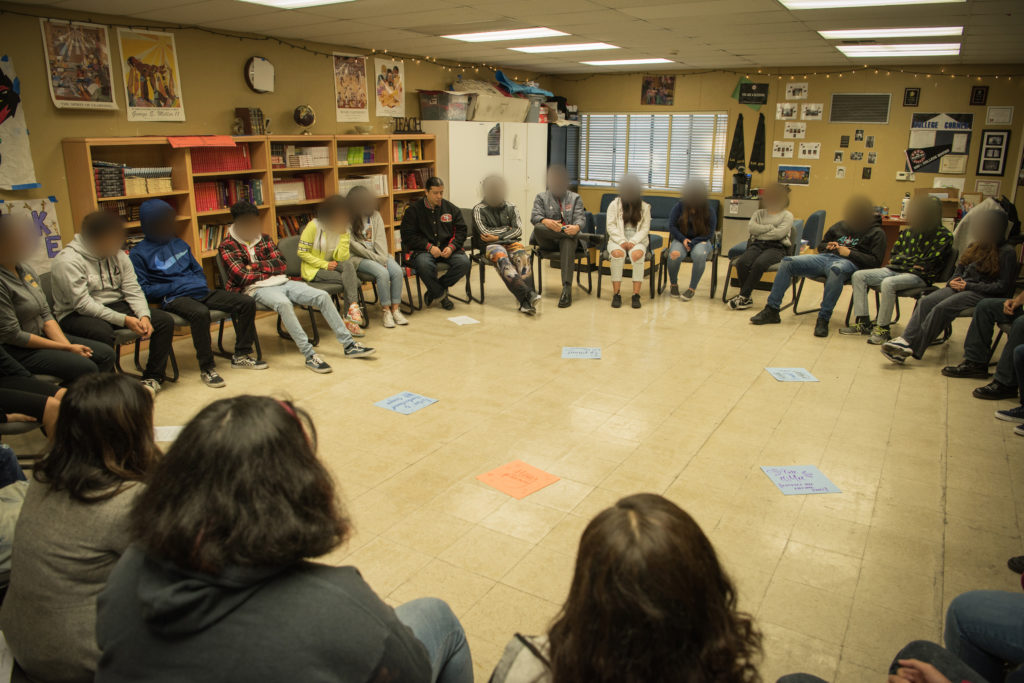
Mario Valladolid, above and in the featured photo, leads a community circle with students concerned about immigration issues at San Diego’s Hoover High. (Students faces are blurred out for privacy and protection.)
It’s clear many are traumatized. One girl is weeping. The Educator has agreed not to use students’ real names or show their faces in this story because it might target them or relatives for deportation.
The teens express a strong desire to do something to help their families and communities, but they feel helpless. They try to distract themselves with social media and activities with friends and family. But there’s no escape from the constant worry.
“I’m trying very hard to cherish the things I now have,” says the girl who was crying. “You never know when everything might be taken away from you.”
“You can’t treat trauma with discipline. Instead, you have to create a culture where every student feels welcome and safe.”
— Mario Valladolid, San Diego Education Association
Students are losing hope
The trauma experienced at Hoover High reflects what is happening nationwide under the Trump administration’s escalating crackdown on immigrants. (In February, news outlets reported that elite tactical agents were being deployed to various sanctuary cities to bolster Immigration and Customs Enforcement operations; ICE says operations have been scaled back during the COVID-19 pandemic, but many question that claim.) Students are traumatized, and it has negatively impacted their emotions, academic performance, attendance and behavior, say educators. Valladolid calls it a classroom crisis that is hurting an entire generation of students.
“I want my students to come to school and learn and not worry about things beyond their control,” says Valladolid, a member of San Diego Education Association (SDEA). “You can’t treat trauma with discipline. Instead, you have to create a culture where every student feels welcome and safe.”
In 2018, the UCLA Civil Rights Project surveyed staff in 730 U.S. public schools and found that 64 percent of employees said the stepped-up home raids, deportations and family separations hurt students. Ninety percent of administrators noted increased behavioral and emotional problems among immigrant students; 70 percent reported an academic decline and increased absenteeism. A decreased desire to go to college was reported among older immigrant students. They are giving up hope. Many think it no longer matters to do well in school.
“Some kids are catatonic. Some kids won’t eat. Some kids have given up trying. The horror that’s raining down on these kids is stunning,” says the study’s lead author, UCLA professor Patricia Gándara.
Paul McCarthy, a teacher at San Francisco International High School, can relate to the study’s findings regarding student motivation since the 2016 election.
“There’s definitely a change in immigrant students,” says the United Educators of San Francisco member. “Before the election, it was easier to convince them of the value of getting good grades and going to college. Now that’s a harder sell. We try to bring back alumni who have succeeded, so they will see success is possible.”
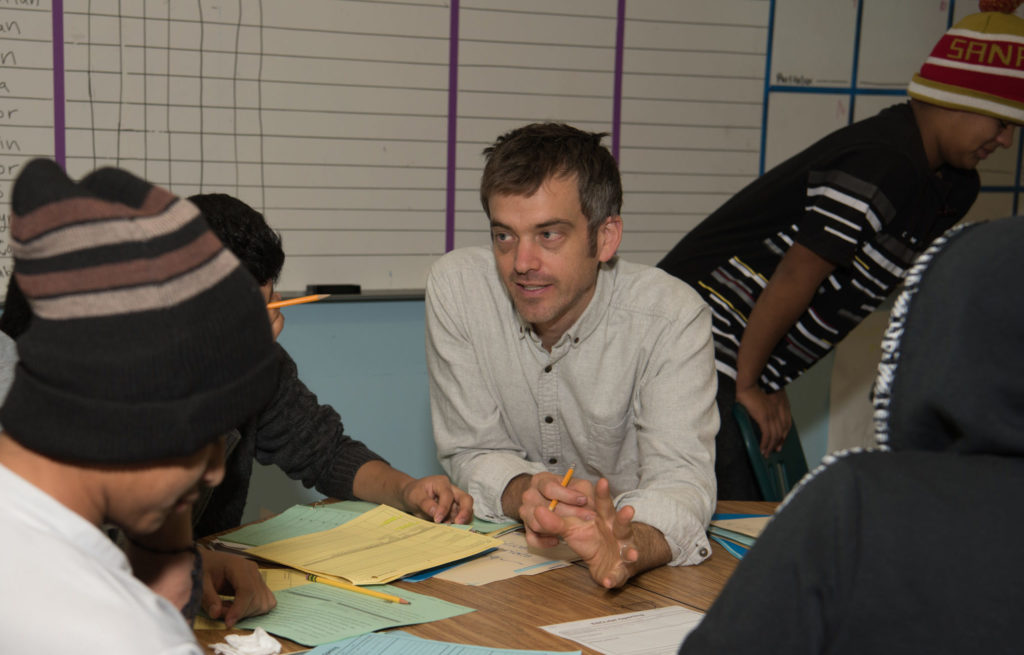
Paul McCarthy with students at San Francisco International High School.
While California is a sanctuary state and schools have declared themselves safe havens, many students are too frightened to trust school employees due to fear of being reported to authorities, the study reports.
Shane Parmely, an English and art teacher at Bell Middle School in San Diego, became acutely aware of how immigration issues can affect students a few years ago when one of her students burst into tears and confided that her mother had been deported, leaving the girl and three siblings in the care of an 18-year-old sister. “That really put the issue on the radar for me,” says the SDEA member, who took the family shopping for food and immediately became an activist on behalf of immigrants. “That’s when I first became aware that kids could be left alone to fend for themselves.”
Parmely, a 2019 CTA Human Rights Award recipient, works with nonprofits that provide food, shelter, transportation and medical care for immigrants as they await their appeals to be processed. She has opened her home to families needing shelter.
“The reality is that families are being ripped apart and children are traumatized and coming to school that way,” Parmely says. “Some display extreme behaviors, and then you find out one of their parents has been deported or their family is in chaos. How can you expect them to be focused on school, get along with others and have good social-emotional skills when they are so on edge?”
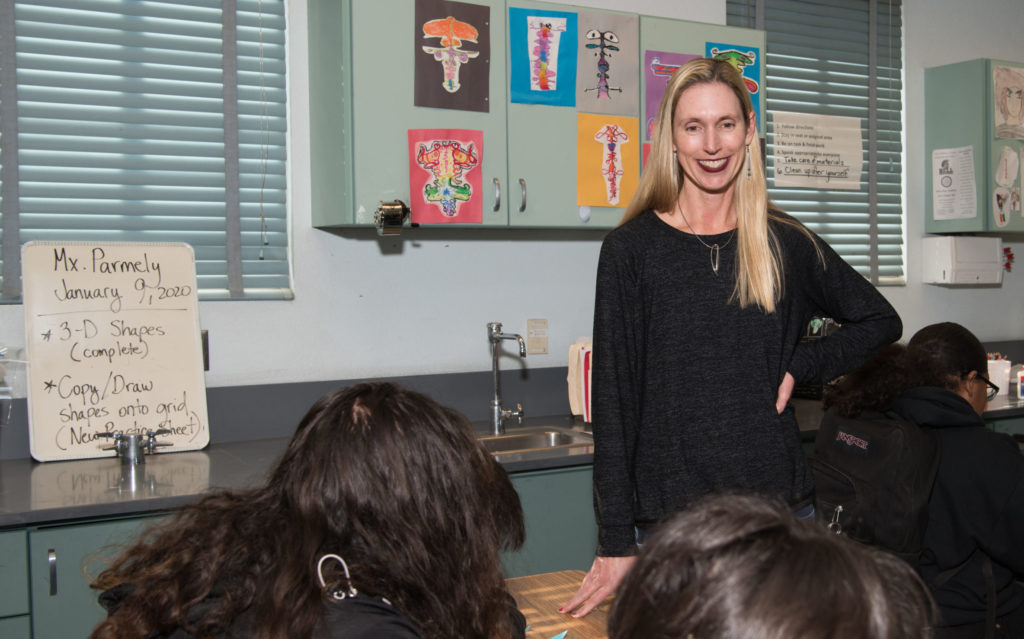
Her students are traumatized, but at least they’re not in cages like youths in detention centers. “We’ll see even higher levels of trauma when those students finally arrive in our schools,” she predicts.
California schools: Ground zero for trauma
Approximately 250,000 undocumented children ages 3-17 are enrolled in California public schools. They are promised a free K-12 education by the U.S. Supreme Court ruling in Plyler v. Doe. California has approximately 750,000 K-12 students with undocumented parents. Many families have mixed status because some family members are U.S. citizens and some aren’t. Of the more than 2 million undocumented residents living in California, 69 percent are from Mexico and 11 percent are from El Salvador, Guatemala and Honduras.
More than 28,000 children who crossed the border without their parents live in California. If a minor turns themself in or is detained by immigration authorities, they are processed by the Office of Refugee Resettlement and sent to live with relatives or friends, or put in a detention center pending their court date.
Students who experience immigration-related trauma live in constant fear that they or family members will be locked up or deported. Trump initially promised to target “criminals,” but the majority of those in detention — nearly 70 percent — have no criminal record, reports the Washington Post.
Immigration anxiety compounds existing stress among Latino students. Research shows 80 percent live in poverty and one-third are English learners. They are bullied in school and lack access to health care. Only 12 percent attain a four-year degree, and undocumented students lack access to federal financial aid, making college less attainable.
“Social justice and immigration issues are closely intertwined and really affecting our students,” says Valladolid. “It’s so sad to see this happening in the 21st century in the richest country in the world.”
New DACA dilemmas
Jose, born in Mexico, moved to California when he was 1. The U.S. is the only home he knows. Now he fears deportation to a country he doesn’t remember. He worries he won’t be able to work or attend college.
Jasmin was also brought to the U.S. as a young child from Mexico. She is determined to go to college and has received a scholarship for undocumented students. She is trying to stay optimistic and wants a medical career.
These 11th graders at Luther Burbank High School in Sacramento consider themselves to be Dreamers — from the DREAM (Development, Relief, and Education for Alien Minors) Act, a proposed federal bill that would grant residency status to qualifying immigrants who entered the U.S. as minors. But they cannot apply for DACA (Deferred Action for Childhood Arrivals), a policy established by a 2012 executive order from President Obama allowing undocumented youths who arrived in the U.S. before age 16 to enroll in school and hold jobs. Students had to be 15 to apply, and today DACA is closed to new applicants, including these youngsters who missed out. The Supreme Court is expected to decide by June whether President Trump can end the program.
For students like Jose, who grew up expecting to enroll in DACA, the federal government’s backpedaling has been devastating.
“I feel like I don’t have a voice here,” he says. “I feel like I don’t matter.”
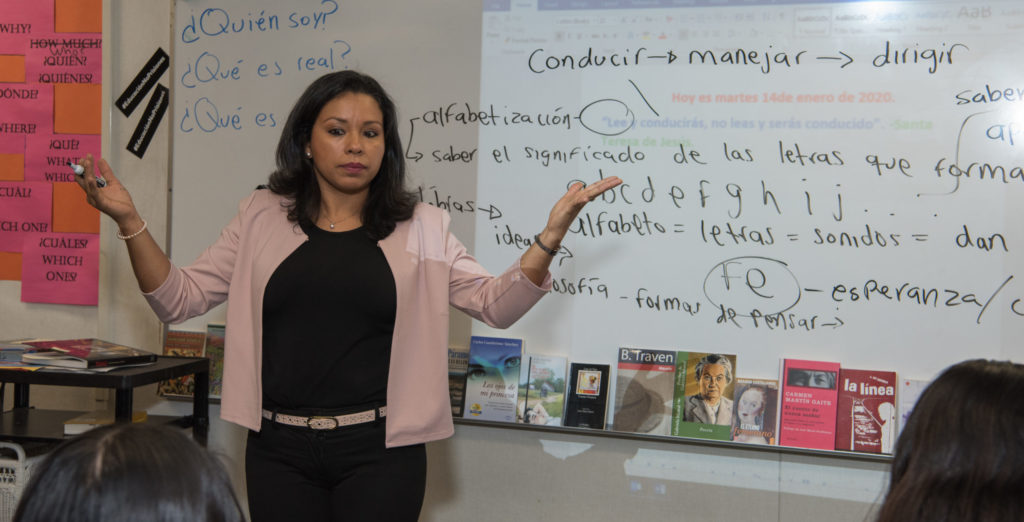
Elizabeth Villanueva, a member of Sacramento City Teachers Association, tries to keep Dreamers focused on success at Burbank High School.
Burbank High Spanish teacher Elizabeth Villanueva, a member of Sacramento City Teachers Association, tries to keep Dreamers focused on success and helps them navigate the system. She takes them to visit colleges. She explains about AB 540, which allows undocumented students access to in-state tuition rates for California’s public colleges and universities, and the California DREAM Act, which allows AB 540 students to apply for state-funded Cal Grants and non-state-funded scholarships. She also encourages students already in DACA to re-enroll early as a precaution. To help students remain calm, she teaches them meditation and breathing exercises, and encourages them to “live in the moment.”
“I tell them to achieve the best academic record possible,” says Villanueva, a CTA Human Rights Award winner. She meets with Dreamers and holds parent information meetings and “Know Your Rights” workshops where guest speakers discuss immigration law and college planning. “I understand students’ frustration and lack of hope, but I tell them they are not hopeless. It’s important to focus on positive aspects to build their confidence.”
Anxiety over DACA has also traumatized teachers. Valladolid, for examples, anguishes that he did the wrong thing by encouraging students to come “out of the shadows” and enroll in DACA, because now the government has their information on file and may deport them.
DACA-enrolled teachers like Angélica Reyes, a world history teacher in a Los Angeles high school she does not want identified, are fearful of what could happen.
“I’m scared that one day my son will be waiting for me at school, not knowing why I didn’t pick him up. The thought of being detained and separated from my family is horrifying,” Reyes says.
Her parents brought her here from Mexico at age 1 and made a living as street vendors. “Today I’m a role model for my students. I hope that when they see me, they know they can achieve their dreams, too.”
Reyes is an activist for Dreamers and is involved with nonprofits including MEChA (Movimiento Estudiantil Chicano de Aztlán), which seeks to promote Chicano unity and empowerment through political action.
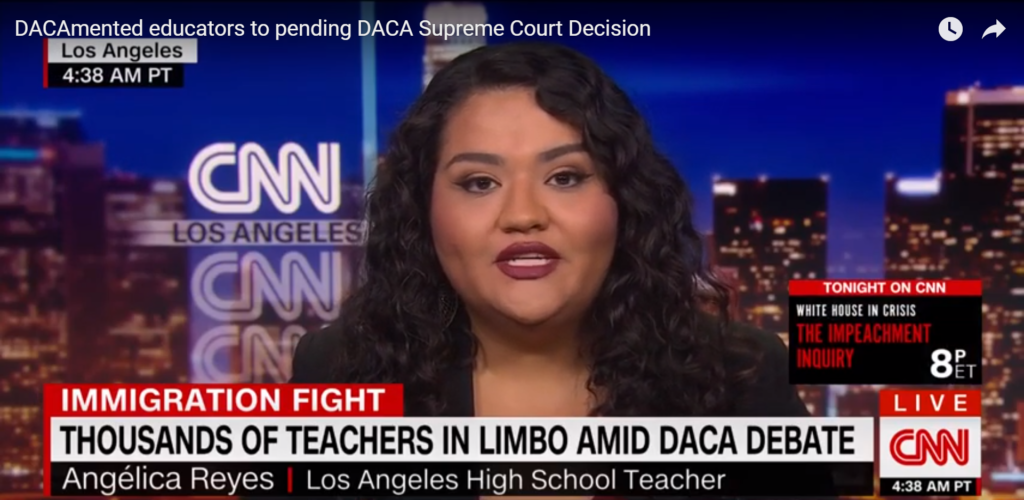
UTLA member Angélica Reyes advocates for immigrants.
“My activism feels like I am contributing to my community, fighting back and resisting,” says Reyes, a member of United Teachers Los Angeles. “I’m doing it for myself — and my students.”
Yolanda Gooch, SDEA member and restorative justice teacher at Hoover High, says, “The immigration issue impacts me greatly. I feel frustrated at the constant conflict my students are experiencing within the system. I see beautiful families, made up of law-abiding citizens, being torn apart. I had a student who got into UC San Diego and then her parents were deported. Now she is the caretaker for her younger siblings.”
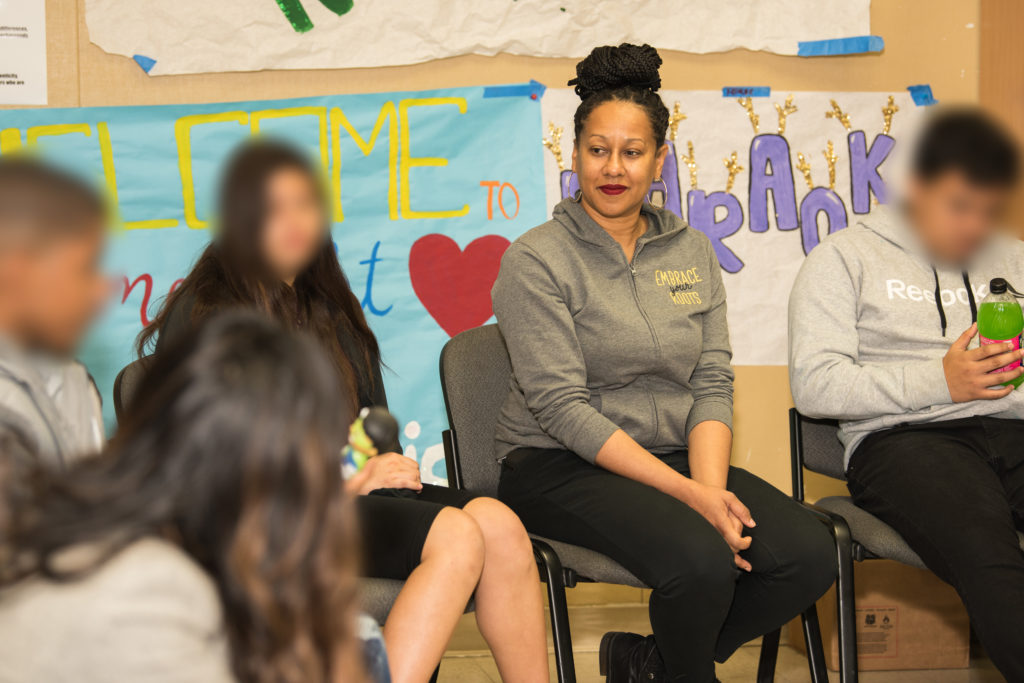
Gooch, whose classroom was used for Valladolid’s community circle, is a staunch advocate for these students. “My goal as your teacher is to help you have access to everything you need and help you achieve your dreams.”
“I’ve had students whose family members were kidnapped or killed in front of them. You can see the symptoms of their anxiety. They shut down. They have short tempers. But I am inspired by them every day. They are so resilient and persistent.”
— Paul McCarthy, United Educators of San Francisco
Newcomers
Newcomers are often traumatized from experiences in their homeland, so they have very real fears about what could happen to them or relatives if they are deported.
“I’ve had students whose family members were kidnapped or killed in front of them,” says McCarthy. “You can see the symptoms of their anxiety. Their head is down. They shut down. They won’t talk. They’re a puddle on the table. They have short tempers. But I am inspired by my students every day. Despite the trauma they have experienced, they are so resilient and persistent.”
One of his male students says, “In Honduras, I had problems. Gangsters almost killed my brother. They shot him two times. I hid under the bed. I felt my life was threatened. So I came here. And when I walk around here, I feel safe. At first, I was nervous at school because I didn’t know English and it’s hard to learn. But the teachers are helping me to get better.”
“You can’t imagine some of the horror these students have experienced,” says Patricia Segura, a teacher on special assignment at Fremont High School in Oakland, who coordinated the school’s newcomer program for years, mostly serving students from El Salvador, Honduras and Guatemala. “Ask why they left and they say things like, ‘So-and-so got killed and I knew I was next.’”
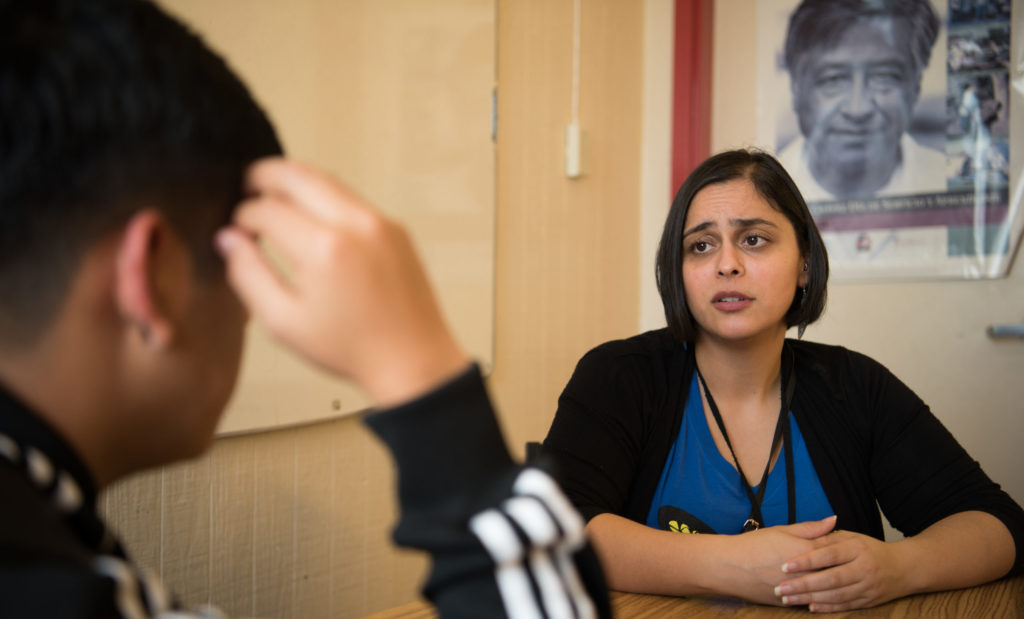
Oakland Education Association member Patricia Segura hears the story of a student at Fremont High School who fled Guatemala to escape gang violence and fear of being killed.
Martin, 16, tells his story in Spanish through tears. Since the age of 5, he worked to support his mother and four younger siblings in Guatemala instead of attending school. His father was a gang member and drug dealer. Gang members poisoned and killed him. Gangs were threatening to kill Martin unless he joined. To escape, Martin and his mother crossed into Mexico and then illegally entered the United States. They are seeking asylum and living with a relative. Meanwhile, he works as a dishwasher.
Adjusting to Fremont High School has been difficult. He is depressed about leaving his siblings and began cutting himself with sharp objects.
“I took out the pain that was inside me with these wounds,” he explains. “And I got very nervous and angry and wanted to be left alone. I didn’t want to harm anyone.”
Eventually a sympathetic teacher helped him find better ways of coping, including sports. Recently classmates cried and hugged him when he shared his story with them. He tries to stay hopeful about the future, but worries he will be deported and end up like his father.
When newcomers first enroll in Oakland, says Segura, staff try to meet their basic needs, connecting them to services like an immigration lawyer (asylum seekers must prove that it is unsafe for them to return to their own country), health care and mental health services. Unfortunately, it’s not unusual for newcomers to refuse mental health services. In their culture, therapy may be seen as a weakness instead of a way to work through problems.
Segura says that if students are closed off and refuse counseling, staff try to involve them in activities they enjoy, such as the Soccer Without Borders Program or school leadership roles. “We find places where they can shine and help them create new and better memories.”
Sadly, immigrant youths — especially unaccompanied minors — are susceptible to becoming gang members here, despite the irony of fleeing their homelands to escape gang violence.
“They get bullied and don’t have a community, so if that’s the community that reaches out to them, they may see no other option,” says Segura, a member of Oakland Education Association. “They perpetuate the cycle.”
“It’s a huge problem,” says McCarthy. “We try very hard to give them other options and connections to keep them out of gangs. If they can find respect on the soccer fields, respect in student government, are engaged in their classes and see a future that is possible, that’s the best gang prevention tool we have.”
Unaccompanied
Luis, 17, is a senior at Redwood High School in Visalia. He grew up in Mexico with his parents and brother. One day he came to the U.S. to visit family members; he thought he was on vacation. After a few days, his parents called him from Mexico and gave him the choice of staying. He said yes, despite being 15 and unable to speak English.
“It was very hard,” he recalls. “When I said yes, my mother was crying.”
Luis moved in with an uncle he barely knew. After graduation, he is expected to work and send money home to support his family.
“It’s a lot of responsibility for an unaccompanied minor,” says Ana Romo, Luis’ English language development teacher. “Their parents send them here to have a better life, and then ask them to return the favor. That is the mindset.”
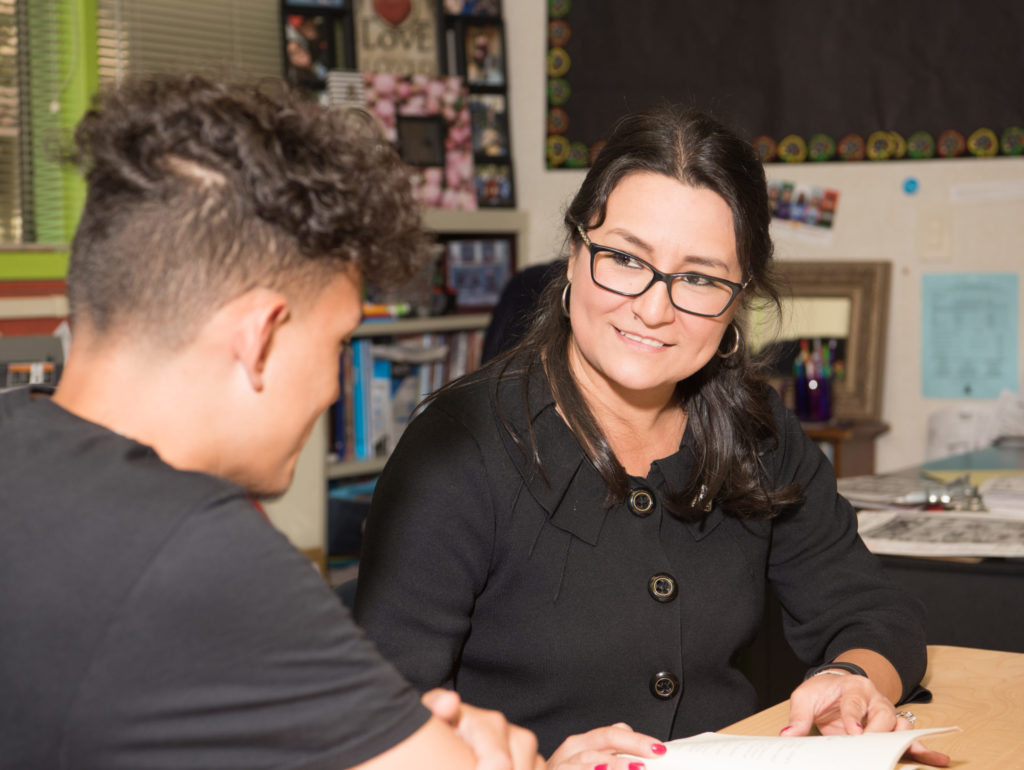
Visalia Unified Teachers Association member Ana Romo has been a positive force in the life of Luis, an unaccompanied minor who attends Redwood High School.
One of her female students from El Salvador crossed the border because her mother feared she could be raped and kidnapped. Now she attends College of the Sequoias. Another named Michelle came as an unaccompanied minor because attending high school and college is a luxury few can afford in Mexico. Now Michelle attends UC Davis.
“Miss Romo helped me, because she didn’t feel sorry for me,” says Michelle. “She told me that crying wouldn’t fix anything. She looked at me as a normal student and not just an immigrant. She helped me apply for college and scholarships. Being an unaccompanied minor is hard, but I’m going after the American Dream.”
Last year was difficult for Luis, says Romo, a member of Visalia Unified Teachers Association (VUTA). He became rebellious. Romo talked to Luis at length about focusing on school and making his parents proud. His uncle told her, “So you’re the one he complains is picking on him. Please keep doing it. He listens to you.”
“These children desperately need our help to receive an education, which is the right of any child. It is important not only to help them for their sake, but also for the sake of our country. These children are our future.”
—Raul Gonzalez, Visalia Unified Teachers Association
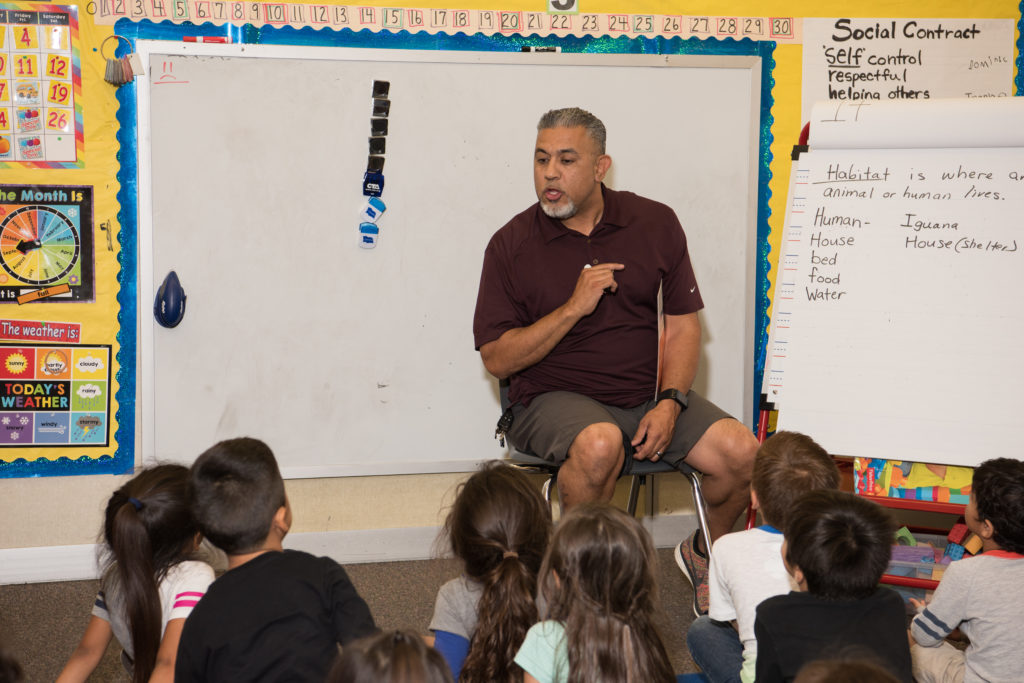
Raul Gonzalez at Crestwood School in Visalia.
The lines have blurred as to what an unaccompanied minor is today, says Raul Gonzalez, who teaches kindergarten at Crestwood School in Visalia and has undocumented family and friends. While most people think of teens running across the border alone as being the only type of unaccompanied minors, the same result happens when parents return to their homeland — voluntarily or through deportation — and teens are left in the U.S. alone.
Teachers say unaccompanied minors in their classrooms usually live with relatives or friends and are expected to work. Some teachers have had students cross the border into the U.S. alone and reunite with a parent they haven’t seen in years — who may have started a new family in America. The reunions are often disappointing and unhappy because students have anger issues over being separated in the first place. This can cause behavior problems.
“No matter how they arrived here, we need to help these children,” says Gonzalez, a VUTA member. “They have fled war-torn countries where there is violence and no law enforcement. We cannot send them back to dangerous situations. Some have requested asylum, and their cases may not be heard for years. Meanwhile, they desperately need our help to receive an education, which is the right of any child. It is important not only to help them for their sake, but also for the sake of our country. These children are our future.”
“Crisis in Our Classrooms” is part of our special report on Teaching Through Trauma. Other stories and resources in the series:
Stories
- Teaching Students with Trauma: Practices that work
- A Culture of Compassion: What trauma-sensitive schools look like
- Phoenix Rising: Healing after natural disasters
- Crisis in Our Classrooms: Frightened, anxious immigrant students try to focus on education
- How COVID-19 Impacts the Undocumented
- Returning to Children’s Community Charter School in Paradise
- No Such Thing as a Bad Kid: Youth-care expert Charles D. Appelstein
- Taking Care of You, Too: Educator self-care is critical
- In Their Own Words: Helping students tell what they’ve lived
Resources
- How to help students after disaster
- Restorative practices that aid in trauma recovery
- Trauma Toolkit for Educators
- Helping our immigrant & undocumented students
- Know your rights with ICE
- Educator self-care tip sheet
- Defining trauma
- Symptoms of trauma
- Guidance from UC San Francisco’s HEARTS
The Discussion 0 comments Post a Comment